Please post everything you have an French SPAA units!
Please post everything you have an French SPAA units!
Very important, every single variant you know!
Was the Twin 25mm CA mle 1940J ever mounted on a truck to make it SPAA??
Please MODS don't move this into the Allied section, need this as soon as possible and Axis forum are more visited.
Was the Twin 25mm CA mle 1940J ever mounted on a truck to make it SPAA??
Please MODS don't move this into the Allied section, need this as soon as possible and Axis forum are more visited.
please forgive the repost... Some here might be interested (or not  )
)
French self-propelled light anti-aircraft guns, 1927 to 1942
In the late 1920s the Hotchkiss company started developing self-propelled anti-aircraft mountings, using its range of 13.2 mm and 25 mm guns, in cunjunction with several car manufacturers.
Citroën-Kégresse P4T(1927)
The first prototype was based on the P4T half-track chassis from Citroën-Kégresse. A quadruple Le Prieur-type 13.2 mm mounting was fitted on a crude wooden platform with no provision for ammo storage. Twin wheels were fitted forward. Trials performed near Paris and in the Landes region demonstrated the vehicle was
severly underpowered. Due to interest from the Chilean military, trials continued, and revealed a serious lack of stability. The project was abandoned in 1929.
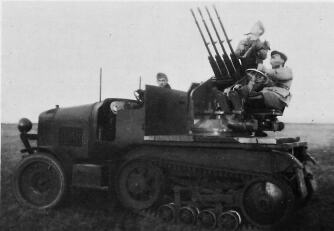
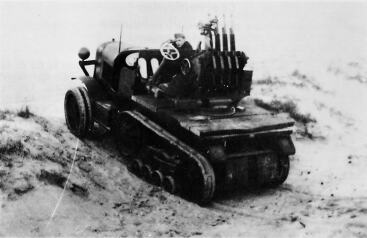
Citroën-Kégresse P19 (1932?)
Due to renewed interest from Chile, Around 1932, Hotchkiss fitted a twin 13.2 mm mounting to a P19 half-track chassis, with a platform organized not unlike Berliet experiments.
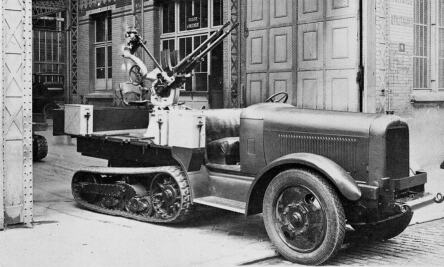
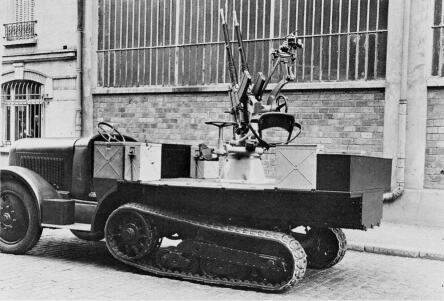
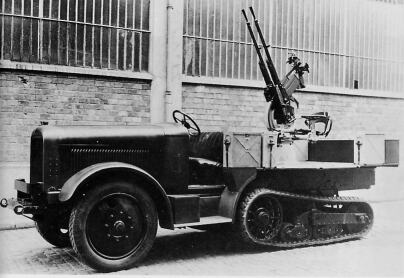
Renault (1928-1932?)
Not much is known about this experiment with a Renault chassis. The platform hosts a quadruple 13.2 mm mounting with a two-gunner configuration, similar to the naval mountings.
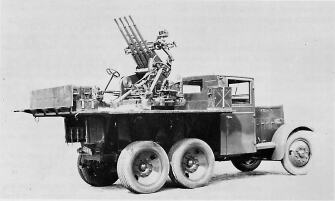
Berliet VPM (1928)
Berliet revealed this uncomplete prototype at the Salon de l'Automobile in 1928. The six-wheel chassis with twin wheels on the central axle was derived from the VPRM armoured car project. "Legs" could be deployed to help stabilize the chassis while firing. This prototype was not completed.
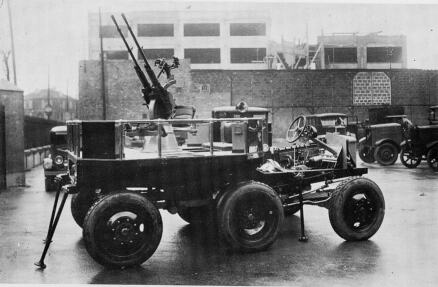
Its characteristics were the following:<br>
weight: 6200 kg
length: 4.5 m
width: 2.06 m
wheelbase (axle-to-axle): 1.65 m
engine make: Berliet
power: 62 hp (metric)
# of cylinders: 6
cubic capacity: 4085 cc
fuel capacity: 85 l
armament:
2 x 13.2 mm Hotchkiss
Berliet VPR2 (1930)
Berliet presented the VPR2 prototype in 1930. Like the VPM, it was a six-wheel chassis with twin wheels on the central axle. The prototype was rather completewith ammunition storage, seats for the four-man crew, and so on. Extensive tests were ran with both a twin and a single 13.2 mm mountings. In either case the gun tripod was simply resting on the platform. Trials demonstrated the chassis needed to be strenghtened, and the VPR2 did not enter production.
However, the single example did see operational service as part of the anti-aircraft defense system around Toulon.
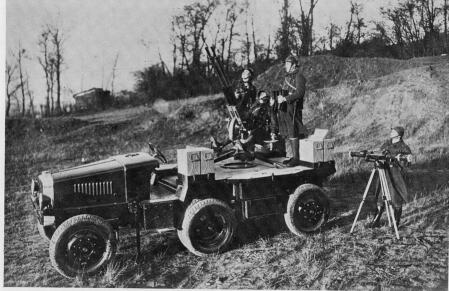

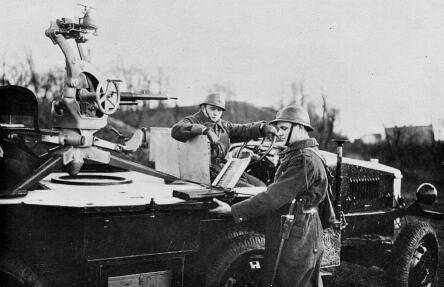
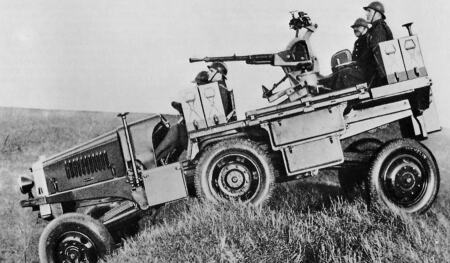
Characteristics:
weight: 4500 kg
length: 4.8 m
width: 1.94 m
height: 2.30 m
wheelbase:
- front: 1.82 m
- aft: 1.75 m
engine make: Berliet
power: 40 hp (metric)
# of cylinders: 6
cubic capacity: 2736 cc
fuel capacity: 120 l
max speed: 53 km/h
endurance: 300 km
max slope: 60%
tyres: 36 x 8.25
crew: four men
- driver and rangefinder operator
- loader
- gunner
- sighting system operator
armament:
2 x 13.2 mm Hotchkiss or 1 x 13.2 mm Hotchkiss
1440 rounds on storage boxes on platform
2500 rounds under platform
Berliet VPH (1932)
As a response to issues with the VPR2, Berliet introduced the VPH in 1932. The chassis was strenghtened, the tyres larger and the platform could accomodate more ammunition. The twin mounting was permanently fixed to the chassis (naval mount?). Two examples were built and accepted for service, but no further production took place.
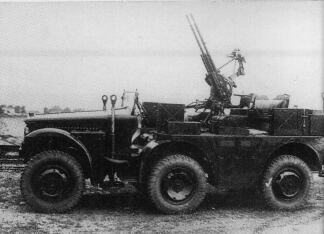
Characteristics:
weight: 6200 kg
length: 5.07 m
width: 2.10 m
wheelbase (axle-to-axle): 1.90 m
engine make: Berliet
power: 62 hp (metric)
# of cylinders: 6
cubic capacity: 4085 cc
fuel capacity: 80 l
max speed: 44.5 km/h
armament:
2 x 13.2 mm Hotchkiss
Berliet 25 mm (1940?)
At least one prototype with a twin 25 mm mounting was trialed, probably in 1940. It was externally similar to the VPH. Ferrard mentions that a few self-propelled 25 mm guns were manufactured in 1940, but does not say whether they were from Berliet or not.
Unidentified (1936)
This unindentified six-wheel chassis featuring a twin 13.2 mm mounting was seen during manoeuvres in the Alps in August 1936.
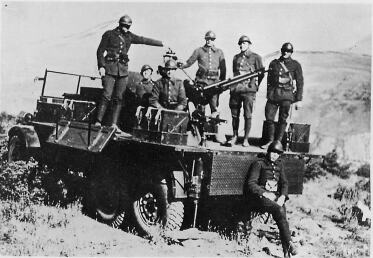
Unidentified (1941?)
This picture is usually said to be showing one of the truck-mounted 20 mm mle 39 Oerlikon gun that were on the French OOB during the Franco-Siamese conflict in Indochina in 1941. However, the gun looks more like a 13.2 mm mle 1930 Hotchkiss. The chassis is unidentified.
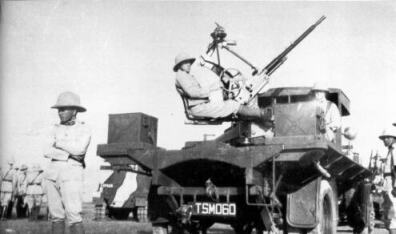
GMC ACK (1941)
This GMC truck was modified in Morocco in 1941 to accomodate a 25 mm mle 1938 Hotchkiss gun, complete with its crew and 270 rounds. The Germans and Italians allowed Vichy authorities to perform firing tests in August 1941. A Citroën C45 chassis with a 25 mm CA mle 39 gun was to be built and trialed too. Not much more is known.
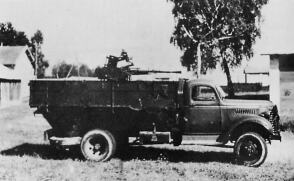
Free French trucks (1942)
Free French troops were equipped with several self-propelled 13.2 mm mountings during the battle of Bir Hakeim. The quad mounting below is served by sailors. It could have been recovered from a French ship held in Great Britain after July 1940. The truck chassis seems to be a Chevrolet 15cwt (thx Torgen).
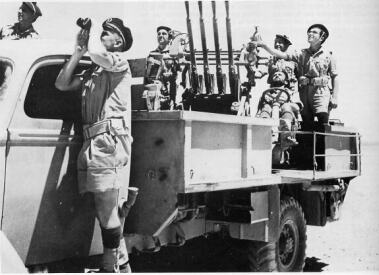
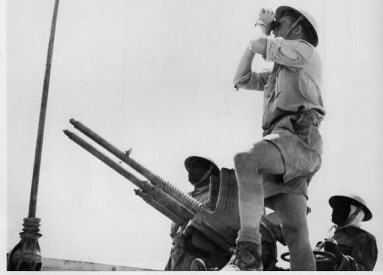
That's about all I know. Main reference are Pierre Touzin's books, except when reference is indicated.
French self-propelled light anti-aircraft guns, 1927 to 1942
In the late 1920s the Hotchkiss company started developing self-propelled anti-aircraft mountings, using its range of 13.2 mm and 25 mm guns, in cunjunction with several car manufacturers.
Citroën-Kégresse P4T(1927)
The first prototype was based on the P4T half-track chassis from Citroën-Kégresse. A quadruple Le Prieur-type 13.2 mm mounting was fitted on a crude wooden platform with no provision for ammo storage. Twin wheels were fitted forward. Trials performed near Paris and in the Landes region demonstrated the vehicle was
severly underpowered. Due to interest from the Chilean military, trials continued, and revealed a serious lack of stability. The project was abandoned in 1929.


Citroën-Kégresse P19 (1932?)
Due to renewed interest from Chile, Around 1932, Hotchkiss fitted a twin 13.2 mm mounting to a P19 half-track chassis, with a platform organized not unlike Berliet experiments.



Renault (1928-1932?)
Not much is known about this experiment with a Renault chassis. The platform hosts a quadruple 13.2 mm mounting with a two-gunner configuration, similar to the naval mountings.

Berliet VPM (1928)
Berliet revealed this uncomplete prototype at the Salon de l'Automobile in 1928. The six-wheel chassis with twin wheels on the central axle was derived from the VPRM armoured car project. "Legs" could be deployed to help stabilize the chassis while firing. This prototype was not completed.

Its characteristics were the following:<br>
weight: 6200 kg
length: 4.5 m
width: 2.06 m
wheelbase (axle-to-axle): 1.65 m
engine make: Berliet
power: 62 hp (metric)
# of cylinders: 6
cubic capacity: 4085 cc
fuel capacity: 85 l
armament:
2 x 13.2 mm Hotchkiss
Berliet VPR2 (1930)
Berliet presented the VPR2 prototype in 1930. Like the VPM, it was a six-wheel chassis with twin wheels on the central axle. The prototype was rather completewith ammunition storage, seats for the four-man crew, and so on. Extensive tests were ran with both a twin and a single 13.2 mm mountings. In either case the gun tripod was simply resting on the platform. Trials demonstrated the chassis needed to be strenghtened, and the VPR2 did not enter production.
However, the single example did see operational service as part of the anti-aircraft defense system around Toulon.




Characteristics:
weight: 4500 kg
length: 4.8 m
width: 1.94 m
height: 2.30 m
wheelbase:
- front: 1.82 m
- aft: 1.75 m
engine make: Berliet
power: 40 hp (metric)
# of cylinders: 6
cubic capacity: 2736 cc
fuel capacity: 120 l
max speed: 53 km/h
endurance: 300 km
max slope: 60%
tyres: 36 x 8.25
crew: four men
- driver and rangefinder operator
- loader
- gunner
- sighting system operator
armament:
2 x 13.2 mm Hotchkiss or 1 x 13.2 mm Hotchkiss
1440 rounds on storage boxes on platform
2500 rounds under platform
Berliet VPH (1932)
As a response to issues with the VPR2, Berliet introduced the VPH in 1932. The chassis was strenghtened, the tyres larger and the platform could accomodate more ammunition. The twin mounting was permanently fixed to the chassis (naval mount?). Two examples were built and accepted for service, but no further production took place.

Characteristics:
weight: 6200 kg
length: 5.07 m
width: 2.10 m
wheelbase (axle-to-axle): 1.90 m
engine make: Berliet
power: 62 hp (metric)
# of cylinders: 6
cubic capacity: 4085 cc
fuel capacity: 80 l
max speed: 44.5 km/h
armament:
2 x 13.2 mm Hotchkiss
Berliet 25 mm (1940?)
At least one prototype with a twin 25 mm mounting was trialed, probably in 1940. It was externally similar to the VPH. Ferrard mentions that a few self-propelled 25 mm guns were manufactured in 1940, but does not say whether they were from Berliet or not.
Unidentified (1936)
This unindentified six-wheel chassis featuring a twin 13.2 mm mounting was seen during manoeuvres in the Alps in August 1936.

Unidentified (1941?)
This picture is usually said to be showing one of the truck-mounted 20 mm mle 39 Oerlikon gun that were on the French OOB during the Franco-Siamese conflict in Indochina in 1941. However, the gun looks more like a 13.2 mm mle 1930 Hotchkiss. The chassis is unidentified.

GMC ACK (1941)
This GMC truck was modified in Morocco in 1941 to accomodate a 25 mm mle 1938 Hotchkiss gun, complete with its crew and 270 rounds. The Germans and Italians allowed Vichy authorities to perform firing tests in August 1941. A Citroën C45 chassis with a 25 mm CA mle 39 gun was to be built and trialed too. Not much more is known.

Free French trucks (1942)
Free French troops were equipped with several self-propelled 13.2 mm mountings during the battle of Bir Hakeim. The quad mounting below is served by sailors. It could have been recovered from a French ship held in Great Britain after July 1940. The truck chassis seems to be a Chevrolet 15cwt (thx Torgen).


That's about all I know. Main reference are Pierre Touzin's books, except when reference is indicated.
- David Lehmann
- Member
- Posts: 2863
- Joined: 01 Apr 2002, 11:50
- Location: France
Hello Pachy,
I expected you to post in this thread Thanks for the very complete report.
Thanks for the very complete report.
The photo in Indochina is from the magazine"Batailles HS n°3 - l'Indochine en guerre (1940-1945)" and the credit for the photo is the "Musée des troupes de Marine" (at Fréjus). The caption indeed indicates a 20mm Oerlikon gun but I am convinced it is a mistake and the gun is a 13.2mm Hotchkiss.
Here is an other truck, mounting a 25mm AA gun.
Regards,
David
I expected you to post in this thread
The photo in Indochina is from the magazine"Batailles HS n°3 - l'Indochine en guerre (1940-1945)" and the credit for the photo is the "Musée des troupes de Marine" (at Fréjus). The caption indeed indicates a 20mm Oerlikon gun but I am convinced it is a mistake and the gun is a 13.2mm Hotchkiss.
Here is an other truck, mounting a 25mm AA gun.
Regards,
David
- Attachments
-
- 25mm CA39 AA gun on truck.jpg (43.12 KiB) Viewed 15899 times
- David Lehmann
- Member
- Posts: 2863
- Joined: 01 Apr 2002, 11:50
- Location: France
In May 1940, the lack of AA guns and AA ammunition was really a strong drawback for the French army.
Without being completely exhaustive and going deep in the details, the French army France had 20x 94mm Vickers AA guns beside about 40x Schneider 90mm AA guns (Mle1926/1930 and 1939) and about 135x 105mm Mle1915/1934 AA guns.
There were about 1695x 75mm AA guns :
- 876x are based on the 75mm Mle1897 gun and fire the 75x350R shell (75mm Mle1913/34, Mle1915/34 and Mle1915)
- 819x 75mm AA guns are based on the 75mm Mle1928 Schneider gun and fire the 75x837R shell (75mm Mle1917/34, Mle1930, Mle1932, Mle1933 and Mle1928/39).
That makes a total of 1890 potentially available heavy AA guns. In comparison at the same time, the Germans had more than 2500 8.8cm and 10.5cm AA guns.
The French army had only about 270 'light' AA guns (13.2mm) and 1331 medium AA guns (20-40mm) available in May 1940. Further deliveries led to about 1900 medium AA guns available. In comparison, the Wehrmacht on 10th May 1940 had about 6500 2.0cm and 3.7cm AA guns covering the troops advancing in France. These AA guns caused the main losses in the French air force while the Luftwaffe encountered much less AA fire.
Most of the light/medium AA guns (and of course the heavier guns) were mounted on trailers, they were not self-propelled. The number of real SPAA guns was very limited, especially concerning the 13.2 / 20 / 25mm guns but there were about 236 75mm AA guns. Nonetheless these guns were used in AA batteries on various points of the front and not for the immediate cover of the moving motorized columns. These 75mm SPAA guns needed also more preparation before being ready for action compared to lighter SPAA I guess.
Therefore most of the of AA protection for the French motorized columns relied on AAMGs (single and twin mountings) and often completely improvised mountings, including every kind of LMGs soemetimes. In several occasions they were successful by shoting down an enemy aircraft. When reading a book about the 1st Spahis Brigade I learned that roughly all of the men fired with their carbines while overflown by German aircrafts (that was in Luxembourg IIR) and they also managed to shot down several planes.
Here are photos of what seem to be rather regular AA mountings for the Hotchkiss Mle1914 MG.
Regards,
David
Without being completely exhaustive and going deep in the details, the French army France had 20x 94mm Vickers AA guns beside about 40x Schneider 90mm AA guns (Mle1926/1930 and 1939) and about 135x 105mm Mle1915/1934 AA guns.
There were about 1695x 75mm AA guns :
- 876x are based on the 75mm Mle1897 gun and fire the 75x350R shell (75mm Mle1913/34, Mle1915/34 and Mle1915)
- 819x 75mm AA guns are based on the 75mm Mle1928 Schneider gun and fire the 75x837R shell (75mm Mle1917/34, Mle1930, Mle1932, Mle1933 and Mle1928/39).
That makes a total of 1890 potentially available heavy AA guns. In comparison at the same time, the Germans had more than 2500 8.8cm and 10.5cm AA guns.
The French army had only about 270 'light' AA guns (13.2mm) and 1331 medium AA guns (20-40mm) available in May 1940. Further deliveries led to about 1900 medium AA guns available. In comparison, the Wehrmacht on 10th May 1940 had about 6500 2.0cm and 3.7cm AA guns covering the troops advancing in France. These AA guns caused the main losses in the French air force while the Luftwaffe encountered much less AA fire.
Most of the light/medium AA guns (and of course the heavier guns) were mounted on trailers, they were not self-propelled. The number of real SPAA guns was very limited, especially concerning the 13.2 / 20 / 25mm guns but there were about 236 75mm AA guns. Nonetheless these guns were used in AA batteries on various points of the front and not for the immediate cover of the moving motorized columns. These 75mm SPAA guns needed also more preparation before being ready for action compared to lighter SPAA I guess.
Therefore most of the of AA protection for the French motorized columns relied on AAMGs (single and twin mountings) and often completely improvised mountings, including every kind of LMGs soemetimes. In several occasions they were successful by shoting down an enemy aircraft. When reading a book about the 1st Spahis Brigade I learned that roughly all of the men fired with their carbines while overflown by German aircrafts (that was in Luxembourg IIR) and they also managed to shot down several planes.
Here are photos of what seem to be rather regular AA mountings for the Hotchkiss Mle1914 MG.
Regards,
David
- Attachments
-
- Hotchkiss twin AAMG on truck.jpg (51.5 KiB) Viewed 15896 times
-
- French truck and Hotchkiss AAMG.jpg (37.86 KiB) Viewed 15895 times
-
- Citroen-Kegresse P19_3 (troop carrier) with Hotchkiss AAMG.jpg (102.25 KiB) Viewed 15895 times
Last edited by David Lehmann on 15 Jul 2005, 01:10, edited 1 time in total.
- David Lehmann
- Member
- Posts: 2863
- Joined: 01 Apr 2002, 11:50
- Location: France
Concerning the 75mm SPAA guns :
Autocanon de 75mm Mle1913/34 (self-propelled)
Calibre : 75x350R mm
Barrel length : 2720 mm (2230 mm rifling)
Weight : 5880 kg
Rate of fire : 12 rpm
Muzzle velocity : 580 m/s (projectile of 6 kg)
Traverse : 237°
Elevation : 0° to +70°
Maximum range : 6500 m
In 1940 57 AA batteries were using the Autocanon de 75mm Mle1913/1934 ... A total of 236 of these SPAAs were used on 10th May 1940. The Germans captured many and still used 45 of them in May 1944.
Several of these SPAA guns were even sometimes used in direct AT role. There is an exemple on the Aa canal between Gravelines and Watten : 2 of these 75mm SPAA guns (402e RADCA) were defending the Saint-Folquin bridge on 24th May 1940. They were supporting the 2nd battalion of the 137e RI against an assaiult of the "Grossdeutschland" regiment supported by elements of the 1.PzD. They managed to destroy 3 German AFVs (Sturmgeschütze III from the Sturmgeschütz-Batterie 640, tanks and/or armored cars from the 1.PzD).
Regards,
David
Autocanon de 75mm Mle1913/34 (self-propelled)
Calibre : 75x350R mm
Barrel length : 2720 mm (2230 mm rifling)
Weight : 5880 kg
Rate of fire : 12 rpm
Muzzle velocity : 580 m/s (projectile of 6 kg)
Traverse : 237°
Elevation : 0° to +70°
Maximum range : 6500 m
In 1940 57 AA batteries were using the Autocanon de 75mm Mle1913/1934 ... A total of 236 of these SPAAs were used on 10th May 1940. The Germans captured many and still used 45 of them in May 1944.
Several of these SPAA guns were even sometimes used in direct AT role. There is an exemple on the Aa canal between Gravelines and Watten : 2 of these 75mm SPAA guns (402e RADCA) were defending the Saint-Folquin bridge on 24th May 1940. They were supporting the 2nd battalion of the 137e RI against an assaiult of the "Grossdeutschland" regiment supported by elements of the 1.PzD. They managed to destroy 3 German AFVs (Sturmgeschütze III from the Sturmgeschütz-Batterie 640, tanks and/or armored cars from the 1.PzD).
Regards,
David
- Attachments
-
- 75mm Mle1913-34 SPAA (autocanon)_1.jpg (88.98 KiB) Viewed 15895 times
-
- 75mm Mle1913-34 SPAA (autocanon)_2.jpg (64.09 KiB) Viewed 15896 times
- David Lehmann
- Member
- Posts: 2863
- Joined: 01 Apr 2002, 11:50
- Location: France
- David Lehmann
- Member
- Posts: 2863
- Joined: 01 Apr 2002, 11:50
- Location: France
- David Lehmann
- Member
- Posts: 2863
- Joined: 01 Apr 2002, 11:50
- Location: France
These are flame hiders (retracted). It was adopted during WW1 especially for the fighting in the obscurity.David Lehmann wrote:A photo taken in Tunisia in 1943 if I remember well : twin Hotchkiss Mle1914 AAMGs mounted on a truck. Note the peculiar feed system and the modification on the barrel.
Regards,
David
- David Lehmann
- Member
- Posts: 2863
- Joined: 01 Apr 2002, 11:50
- Location: France
Hello,
Pachy mentioned Ferrard and Touzin who wrote the books where you will find most of these information.
• "France 1940 – l'armement terrestre" (Stéphane Ferrard)
• "Les matériels de l'armée de terre française 1940" (2 volumes, Stéphane Ferrard)
• "Les véhicules blindés français 1900-1940" (Pierre Touzin)
David
Pachy mentioned Ferrard and Touzin who wrote the books where you will find most of these information.
• "France 1940 – l'armement terrestre" (Stéphane Ferrard)
• "Les matériels de l'armée de terre française 1940" (2 volumes, Stéphane Ferrard)
• "Les véhicules blindés français 1900-1940" (Pierre Touzin)
David